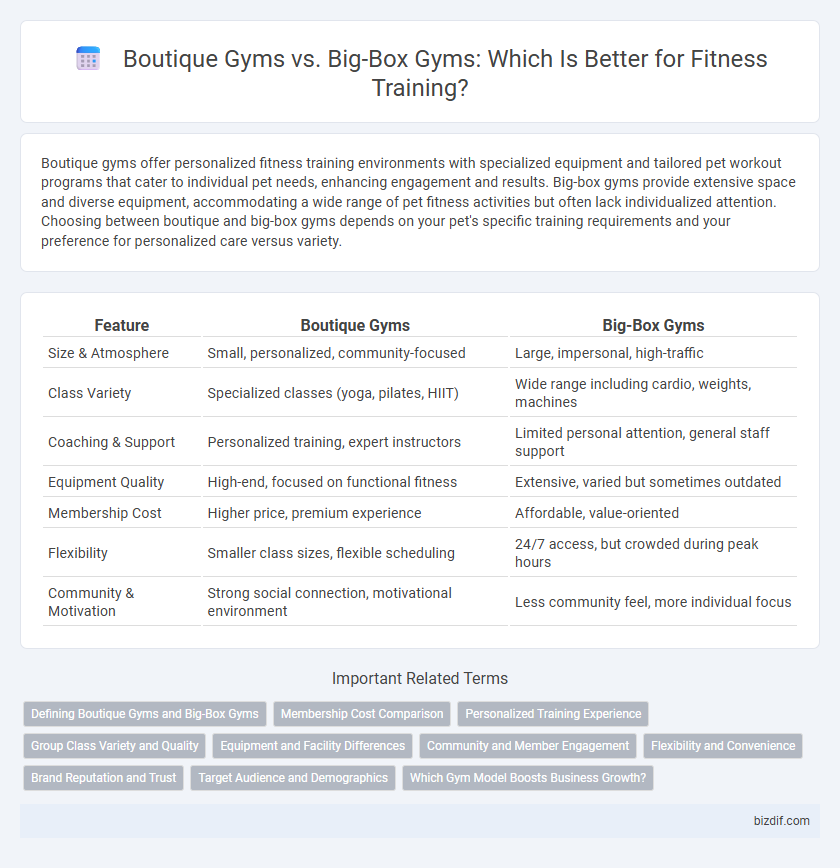Boutique gyms offer personalized fitness training environments with specialized equipment and tailored pet workout programs that cater to individual pet needs, enhancing engagement and results. Big-box gyms provide extensive space and diverse equipment, accommodating a wide range of pet fitness activities but often lack individualized attention. Choosing between boutique and big-box gyms depends on your pet's specific training requirements and your preference for personalized care versus variety.
Table of Comparison
| Feature | Boutique Gyms | Big-Box Gyms |
|---|---|---|
| Size & Atmosphere | Small, personalized, community-focused | Large, impersonal, high-traffic |
| Class Variety | Specialized classes (yoga, pilates, HIIT) | Wide range including cardio, weights, machines |
| Coaching & Support | Personalized training, expert instructors | Limited personal attention, general staff support |
| Equipment Quality | High-end, focused on functional fitness | Extensive, varied but sometimes outdated |
| Membership Cost | Higher price, premium experience | Affordable, value-oriented |
| Flexibility | Smaller class sizes, flexible scheduling | 24/7 access, but crowded during peak hours |
| Community & Motivation | Strong social connection, motivational environment | Less community feel, more individual focus |
Defining Boutique Gyms and Big-Box Gyms
Boutique gyms are specialized fitness centers that offer personalized training, small group classes, and a curated atmosphere tailored to specific workout styles like yoga, Pilates, or high-intensity interval training (HIIT). Big-box gyms are large, full-service facilities featuring extensive equipment, diverse class offerings, and amenities such as swimming pools and saunas, designed to serve a broad customer base with flexible membership options. The distinction lies in size, customization, and community engagement, with boutique gyms emphasizing intimate experiences and big-box gyms providing comprehensive fitness solutions.
Membership Cost Comparison
Boutique gyms typically charge higher membership fees, often ranging from $100 to $300 per month, reflecting their specialized classes and personalized training experiences. Big-box gyms offer more affordable rates, commonly between $20 and $50 monthly, due to their larger scale and extensive facilities. Cost efficiency varies depending on individual fitness goals and the value placed on tailored services versus broader access.
Personalized Training Experience
Boutique gyms offer a personalized training experience through tailored workout plans and close trainer-client interactions, enhancing motivation and progress tracking. Big-box gyms provide diverse equipment and group classes but often lack individualized attention, making it harder to customize fitness programs. Members seeking specific goals typically benefit more from the focused environment of boutique gyms.
Group Class Variety and Quality
Boutique gyms offer a curated selection of group classes often led by specialized instructors, ensuring higher quality and personalized attention. Big-box gyms typically provide a broader variety of classes but may sacrifice individual engagement due to larger class sizes. Members seeking targeted workouts and community-driven experiences often prefer boutique gym group classes over the more generalized options found in big-box gyms.
Equipment and Facility Differences
Boutique gyms often provide specialized, high-quality equipment tailored to niche workouts such as Pilates, CrossFit, or yoga, creating an intimate and personalized training environment. Big-box gyms typically offer a wide range of general fitness equipment, including multiple cardio machines, free weights, and resistance training apparatus, designed to accommodate a large number of users simultaneously. Facility differences include boutique gyms emphasizing curated decor and smaller spaces for focused group classes, while big-box gyms prioritize expansive areas with multiple zones to support diverse fitness activities and long operating hours.
Community and Member Engagement
Boutique gyms foster a tight-knit community through personalized training sessions and tailored group classes, enhancing member engagement and motivation. Big-box gyms offer extensive equipment and amenities but often lack the intimate atmosphere that encourages strong social connections. Members of boutique gyms report higher satisfaction and accountability due to the focused interaction with trainers and fellow participants.
Flexibility and Convenience
Boutique gyms offer personalized workout schedules and specialized classes that adapt to individual fitness goals, providing unmatched flexibility for members. Big-box gyms provide extended hours and multiple locations, enabling convenient access for users with varied routines and travel needs. Both gym types emphasize convenience, but boutique gyms excel in customized experiences while big-box gyms prioritize accessibility and volume.
Brand Reputation and Trust
Boutique gyms cultivate a strong brand reputation through personalized services and niche fitness programs, fostering higher trust among members who value tailored experiences. Big-box gyms rely on widespread brand recognition and extensive facilities, attracting a large customer base focused on accessibility and affordability. Trust in boutique gyms often stems from community engagement and specialized expertise, whereas big-box gyms emphasize consistency and established corporate standards.
Target Audience and Demographics
Boutique gyms cater primarily to fitness enthusiasts seeking personalized training, specialized classes, and a community-driven environment, attracting millennials and urban professionals who value quality over quantity. Big-box gyms appeal to a broader demographic, including families and budget-conscious individuals, offering extensive equipment and flexible hours to accommodate diverse schedules. Understanding these distinct target audiences helps fitness businesses tailor marketing strategies and service offerings for maximum engagement and retention.
Which Gym Model Boosts Business Growth?
Boutique gyms capitalize on personalized training, niche classes, and a tight-knit community, driving higher member retention and premium pricing compared to big-box gyms. Big-box gyms benefit from large-scale operations, diverse equipment, and broader accessibility, attracting a high volume of members but often struggling with lower engagement. Business growth tends to accelerate faster in boutique gyms due to their focused customer experience and ability to adapt quickly to fitness trends.
Boutique gyms vs Big-box gyms Infographic

 bizdif.com
bizdif.com